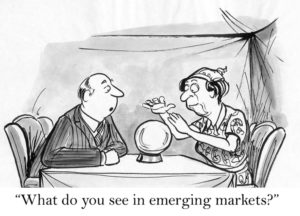Emerging market economies could be at risk as the Federal Reserve begins raising interest rates. Nathaniel Taplin suggests that the Fed could sink emerging markets “again.” He writes:
When the U.S. central bank starts raising interest rates, emerging markets often begin to submerge again: Their borrowing costs rise, their currencies fall and, to add insult to injury, slower U.S. growth dents demand for their products. Will this time be the same as the era of zero interest rates ends?
Much remains uncertain—not least the trajectory of oil prices and war in Ukraine—but it is possible to make a few initial observations. First, several of the large emerging markets under pressure from previous Fed hiking cycles—South Korea in the late 1990s and China in late 2015—look much better insulated now. Big oil or gas importers with high external debt are probably places to avoid. But some of the worst offenders on this account, notably Turkey and Argentina, are already well inscribed on foreign investors’ blacklist.
While it still isn’t clear whether, or where, trouble might pop up this time, understanding how past crises came to pass can aid investors in knowing what to look for. Emerging markets debt and currency crises typically arrive after some combination of the following: financial liberalization, large-scale capital inflows during periods of low global interest rates, a deteriorating trade balance and a domestic investment boom—especially into relatively unproductive assets like housing.
The Asian Financial Crisis, which arrived in 1997 after the low-interest rate years of the early ’90s, was a textbook case: Yield-hungry global investors poured money into fast-growing Asian economies like Thailand and South Korea, helping finance huge housing and investment booms. Partly as a result, those countries found themselves with richly valued currencies, domestic resources tied up in asset bubbles and reduced export competitiveness. That left them vulnerable to capital flight after the global rate environment changed. Farther back, a similar story played out in Latin America in the late ’70s and early ’80s.
More recently, China’s mini debt-and-currency crisis in 2015 and 2016 was fundamentally a result of domestic efforts to deleverage, but it came on the heels of a huge housing investment boom, and it was exacerbated by previous incremental steps to open the capital account and the Fed’s own incipient rate-hiking cycle.
These days, two of the biggest and most important emerging markets— China and South Korea—look well-insulated. China re-tightened controls on money leaving the country in the wake of the 2015 crisis and both countries have enormous war chests of foreign reserves. Korea is a crucial exporter of something the rest of the world can’t get enough of: advanced semiconductors. China might increasingly benefit from conducting its oil trade in its own currency with partners like Russia and Saudi Arabia and, up to a point, from demand for its currency and government debt from other autocratic states.
One potential trouble spot is India, the world’s third-largest crude-oil importer after China and the U.S. Ratings agency Fitch noted in November that its government debt burden of around 90% of gross domestic product is the highest among emerging-market peers in the BBB ratings range. Its total debt burden of 173% of GDP as of last September, according to the Bank for International Settlements, is also high.
Read more here.

